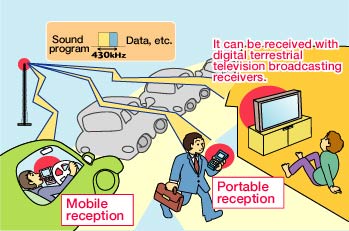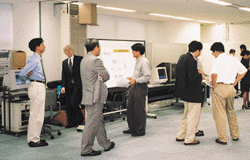|
A Report on the Technical Condition
of Digital Terrestrial Sound Broadcasting
On digital terrestrial sound broadcasting, a draft standard was established
by the Telecommunications Technology Council in November, 1998, followed
by large-scale verification tests conducted by the ARIB (Association
of Radio Industries and Businesses). Based on the test results, the
technical condition of broadcasting systems was reported on in November,
1999.
Digital terrestrial sound broadcasting systems reported on this time
include the following characteristics:
- Diverse broadcasting services are possible that feature high quality
sound broadcasts in addition to data form information (incl. text,
still pictures, and simple animation).
- Adoption of an OFDM (Orthogonal Frequency Division Multiplexing)
modulation scheme that is less affected by multi-pass disturbances,
enabling SFN (Single Frequency Network) .
- Stable mobile and portable reception under severe conditions.
 Adoption
of the MPEG-2 standard, which is commonly used with digital satellite
broadcasting, and the adoption of the same signal structure for use with
digital terrestrial television broadcasting, is expected to bring lower
receiver prices to the market. Also desired is the realization of attractive
new services such as multimedia services for mobile reception as well
as high-quality sound services, for which it is essential to diffuse digital
terrestrial sound broadcasting as a new broadcasting medium. Present AM
and FM broadcasting services will remain as they are now. Digital terrestrial
sound broadcasting will appear as a new service, scheduled to start in
areas where frequency allotments are possible. Adoption
of the MPEG-2 standard, which is commonly used with digital satellite
broadcasting, and the adoption of the same signal structure for use with
digital terrestrial television broadcasting, is expected to bring lower
receiver prices to the market. Also desired is the realization of attractive
new services such as multimedia services for mobile reception as well
as high-quality sound services, for which it is essential to diffuse digital
terrestrial sound broadcasting as a new broadcasting medium. Present AM
and FM broadcasting services will remain as they are now. Digital terrestrial
sound broadcasting will appear as a new service, scheduled to start in
areas where frequency allotments are possible.
Data Broadcasting Verification
Test Conducted
The XML System Working Group of the ARIB (Association of Radio Industries
and Businesses) Digital Satellite Broadcasting System Development Sector
started examining XML-based multimedia coding in March last year. The
Working Group completed a proposal in September, verifying the feasibility
of an actual data broadcasting system based on the equipment backed
by its experiment results.
The test was performed in one of the conference rooms of the NHK Integrated
Technology Inc. Tokyo head office in September last year. An observation
was also held, attended by parties concerned from the Telecommunications
Technology Council and ARIB. The following functions were verified by
the test;
- The appropriate display of still pictures and text layout as intended
by the production process.
- Proper Screen changes according to the selection of inputs on a
menu display.
The following application contents were also verified;
- An independent service which provides artistic still images with
sound.
- Financial information (such as for stock markets).
- Supplemental information services, which provide information directories
for places of interest and popular stores in a town.
- Internet home page contents converted for broadcasting use.
 Based
on the results of these verification tests, a standard for the data broadcasting
system including multimedia coding, was approved at the ARIB Standard
Assembly held on October 26 last year. Now it can be said that the standards
for digital satellite broadcasting are well-established. Based
on the results of these verification tests, a standard for the data broadcasting
system including multimedia coding, was approved at the ARIB Standard
Assembly held on October 26 last year. Now it can be said that the standards
for digital satellite broadcasting are well-established. |

